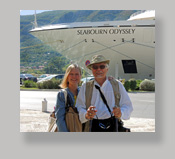 
VENICE | CROATIA | MONTENEGRO | CORFU | KAFALONIA | PYLOS | NAFPLION | PIRAEUS | MILOS | MYKONOS PATMOS | KUSADASI | CHIOS | ISTANBUL DAY 1 | ISTANBUL DAY 2 | ISTANBUL DAY 3 | TRAVEL REFLECTIONS |
 
VENICE | CROATIA | MONTENEGRO | CORFU | KAFALONIA | PYLOS | NAFPLION | PIRAEUS | MILOS | MYKONOS PATMOS | KUSADASI | CHIOS | ISTANBUL DAY 1 | ISTANBUL DAY 2 | ISTANBUL DAY 3 | TRAVEL REFLECTIONS |
MILOS 9-30-12
We spent a week sailing down the Ionian Sea along the Dalmatian coast with its villages of tan houses and red tiled roofs. At Athens/Pireaus the sea became the Aegean and the houses suddenly all turned a stark, bright white - not a muted white among them. It was a busy morning. We drove some miles out of the port city of Filakopi, a Neolithic town, and the nearby Filakapi Caves where pirates hid out in Byzantine times. It was a place that mined obsidian, a natural resource since Milos is a volcanic island. (Hopefully that particular natural resource won't be added to in the near future.) The origin of the island made it rich in minerals but it is also a green and fertile island by contrast, many other Cyclades Islands are rocky and not fertile). In a remarkable bit of long-term vision and planning, a quarter of the island is dedicated to mining activities (bentonite, perlite, and a number of others). Another quarter of Milos, which happens to be on an island right next to Milos but which is still considered Milos, is permanently set aside as a nature preserve. This island has a unique species of lizard, among other plants and animals. One of the memorable events was the persistence of the north wind. It seems that the island is typically windy. In fact, four wind turbines provide enough electricity for a third of the island. This is the second time we were told that wind power provides a considerable part of the electric needs of an island. But this same wind is considered a gift, especially during the summer when temperatures can exceed 100 F for days at a time. If there weren't wind, it might be almost impossible to live on these islands.
Finally, we went to another area of ruins where the Venus de Milo (it should be Venus de Milos) was found. The place is not all that memorable but the story of a local Greek farmer in the 1820's finding the statue, selling it to French officers who had happened by and wanted to give as a present, the local battle between the French and the others on the island who wanted to prevent the French from taking it to their ship offshore was fun. In the same locale were the remnants of a Roman theater and the site of early Christian catacombs. The rhythm of the cruise that seems to work well for us is a tour that starts in the morning around 8:30, finishes by 12:30 or 1, then a return to the ship for lunch. After lunch I take a nap and Carol frequently leaves the ship and walks around whatever the port city happens to be. |